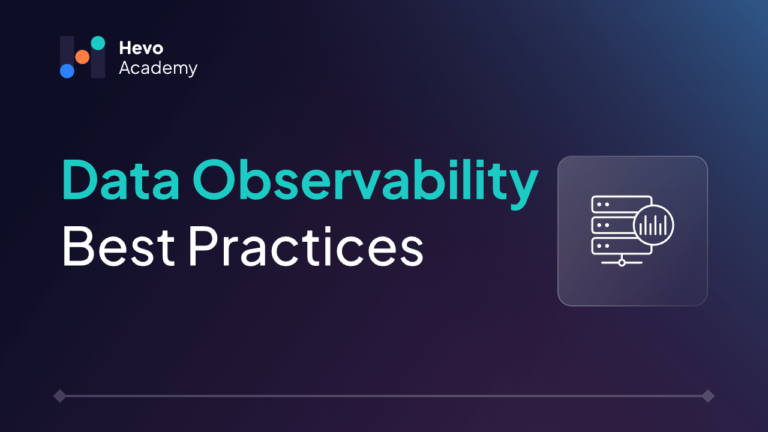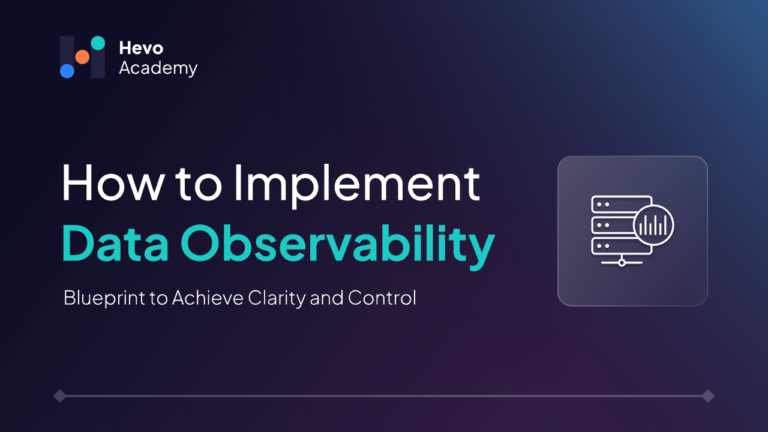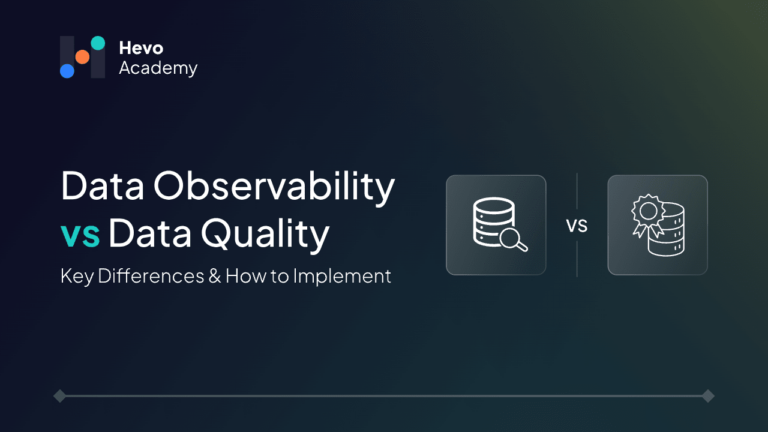Data is the driving force behind all business choices, with the stakes being increasingly elevated.
Table of Contents
Did you know that 70% of organizations face data quality issues that impede their progress and innovation? This statistic vividly illustrates the critical need for strong data observability in today’s data management. Rather than just monitoring, imagine having an instant, deep understanding of your data’s state, source, and trustworthiness. Data observability transcends traditional monitoring by offering a comprehensive view of the entire data landscape, empowering organizations to identify and fix issues before they escalate. In order to remain competitive, businesses must now prioritize effective data observability practices due to the increasing significance of data in strategic decision-making.
In this article, we will explore the top 10 data observability best practices, allowing you to move beyond basic data monitoring and investigate “what is malfunctioning and how can we resolve it?”
Data Observability Overview
In the process of creating a data pipeline, it is important to tackle challenges like problems with data quality, failures in the pipeline, bottlenecks in performance, and lack of visibility. In order to tackle these problems, you may have experimented with various methods, but utilizing data observability can simplify your tasks. Utilizing data observability aids in monitoring and understanding your data environment in real-time becomes easier.
So, what is the definition of data observability? It relates to the ability to monitor and understand the health of your data environment at the same time. It includes methods and instruments that provide details on the data’s integrity, currency, quantity, format, and source. By utilizing data observability, you can detect anomalies in advance, solve issues quickly, and maintain high-quality data to support informed decision-making.
If you think about adding data observability to your existing systems, follow these top steps:
- Assess your existing data architecture to identify monitoring gaps.
- Choose the right tools that meet your requirements, providing functionalities such as automated monitoring and anomaly detection.
- Determine important measures like newness, excellence, and quantity, and establish surveillance for these factors.
- Establish mechanisms for ongoing monitoring of these metrics in live mode.
- Promote collaboration among data engineers, analysts, and business stakeholders to highlight the significance of data observability.
- Consistently assess and modify your observability strategies and tools to align with evolving business demands or technological advancements.
Why is Data Observability Important?
Gartner recently emphasized the significance of data observability, describing it as “the ability of an organization to have broad visibility of its data landscape and multilayer data dependencies, enabling rapid identification and remediation of data outages.”
For organizations aiming to enhance their data management architectures, having data observability systems in place helps:
- To guarantee seamless functioning that anticipates problems and improves data accuracy.
- To improve productivity by automating monitoring, freeing teams for strategic tasks.
- To reduce costs with early issue detection minimizes time and resource expenditure.
Data Observability Best Practices for Effective Data Management
To practice effective data observability, begin by monitoring and understanding the health of your organization’s data—whether it’s data pipelines, infrastructure, or applications. Improve this procedure by blending data observability tools with current management systems for a smooth operation.
Establish protocols for promptly addressing issues by implementing continuous monitoring mechanisms for gathering and evaluating data signals. Adhering to recommended strategies for structured data transparency is crucial for maintaining efficient data control.
The Top 10 Data Observability Best Practices
1. Automated Monitoring
Automated tools constantly track data pipelines, infrastructure, and applications for possible problems. It guarantees immediate identification of irregularities, upholding data integrity and avoiding interruptions.
How to implement:
- Pick the data monitoring tool, compatible with your existing data environment.
- Connect the tool to your current data systems.
- Set up the tool to track important measurements and create automated notifications.
Top Tip: Make sure to frequently update your monitoring tools to keep up with changing data environments.
2. Real-Time Alerts
Real-time alerts that notify you of possible data problems in the moment they happen. This allows for quick reactions to issues, minimizing both downtime and data loss.
How to implement:
- Establish notification systems in your data management tools.
- Establish limits for activating notifications.
- Make sure notifications are dispatched to the correct team members for prompt response.
Top Tip: Personalize notification preferences to reduce incorrect alerts.
Hevo enables you to implement data observability best practices effortlessly. With automated data monitoring and error detection, Hevo ensures your data pipelines are reliable, accurate, and ready for critical decision-making.
Check out what makes Hevo amazing:
- It has a highly interactive UI, which is easy to use.
- It streamlines your data integration task and allows you to scale horizontally.
- The Hevo team is available round the clock to extend exceptional support to you.
Hevo has been rated 4.7/5 on Capterra. Know more about our 2000+ customers and give us a try.
Get Started with Hevo for Free3. Root Cause Analysis
It’s the process of identifying the underlying cause of data issues to prevent future occurrences. Root cause analysis improves problem-solving efficiency and reduces recurring issues.
How to implement:
- Use analytical tools that track data lineage and dependencies.
- Document findings and implement corrective actions.
- Create a structure for performing root cause analysis.
Top Tip: Maintain a knowledge base of issues and resolutions for future reference.
4. Data Lineage Tracking
Recording the flow and transformation of data throughout its lifecycle. It improves traceability and accountability, aiding in troubleshooting and compliance.
How to implement:
- Utilize tools that automatically capture data lineage.
- Consistently check ancestry documents for accuracy.
- Provide relevant stakeholders with access to lineage information.
Top Tip: Integrate data lineage tracking with your data governance practices.
5. Anomaly Detection
Algorithms and models used in anomaly detection are designed to recognize uncommon patterns in data. These algorithms identify concealed problems that traditional monitoring could overlook.
How to implement:
- Deploy machine learning models trained on historical data.
- Continuously update the models with new data.
- Set up alerts for detected anomalies.
Top Tip: Regularly evaluate and refine anomaly detection models for accuracy.
6. Performance Metrics
Key performance indicators (KPIs) that measure the efficiency and effectiveness of data systems. It provides insights into system performance and areas for improvement.
How to implement:
- Define relevant KPIs for your data systems.
- Use dashboards to monitor these metrics in real-time.
- Share performance data with stakeholders to inform decision-making.
Top Tip: Review and adjust KPIs periodically to align with changing business goals.
7. Regular Audits
Periodic reviews and audits of data processes, quality, and compliance ensure data integrity and continuous improvement. It helps with identifying inefficiencies and promoting best practices across the organization.
How to implement:
- Schedule regular audits of your data systems.
- Use audit findings to identify and address weaknesses.
- Incorporate feedback from audits into your data management practices.
Top Tip: Combine automated and manual audits for comprehensive coverage.
8. Cross-Functional Collaboration
Encouraging collaboration between data engineers, analysts, and business stakeholders helps your organization with breaking down silos and fostering a culture of teamwork. It not only improves decision-making and ensures data strategies align with business objectives but also enhances innovation and efficiency across projects.
How to implement:
- Foster a culture of open communication and collaboration.
- Use collaborative tools to share data insights and findings.
- Hold regular meetings to discuss data strategies and progress.
Top Tip: Create cross-functional teams for specific data projects.
9. Comprehensive Documentation
Detailed documentation of data processes, lineage, and issue resolutions help your organization improve transparency and support knowledge sharing. This facilitates smoother onboarding of new team members, ensures consistent practices, and enhances overall data governance.
How to implement:
- Maintain up-to-date documentation for all data processes.
- Use documentation tools that facilitate easy updates and sharing.
- Ensure documentation is accessible to all relevant team members.
Top Tip: Regularly review and update documentation to reflect changes in data processes.
10. Continuous Improvement
A commitment to regularly assessing and improving data observability practices ensures ongoing optimization and adaptation to new challenges. This fosters resilience, drives innovation, and maintains the effectiveness of your data management strategies.
How to implement:
- Set up regular reviews of your data observability practices.
- Solicit feedback from team members and stakeholders.
- Implement changes based on feedback and new industry developments.
Top Tip: Stay informed about the latest trends and technologies in data observability.
Conclusion
Your organization’s data is precious, and simple monitoring won’t solve the challenges of maintaining its integrity and reliability. For complex data world like now, you need more than just basic oversight; you require comprehensive data observability to understand the health and quality of your data. Data observability enables you to proactively identify issues, track data lineage, and ensure that your data is accurate and actionable.
The results? An effective data observability framework possessing all the essential features will streamline data management, improve decision-making with accurate and timely insights, and significantly reduce the time spent searching for data.
Given the complexity of implementing a robust data observability strategy, navigating through various tools can be overwhelming. This is where the experts from Hevo Data come into play. We specialize in planning, arranging, and supervising the entire data integration process to ensure seamless and efficient management of your data landscape. With our help, you can focus on leveraging insights and making informed decisions rather than getting bogged down by the intricacies of data integration.
Connect with us now to transform your data integration experience and maximize the potential of your data!
FAQs
1. What are the four golden signals of observability?
Latency: The time it takes to process a request, affecting the overall user experience.
Traffic: The number of requests received by the system, showing the system’s workload and how it is used.
Errors: The rate of failed requests, which uncover possible problems within the system.
Saturation: The level of resource utilization, showing if a system is getting close to its capacity.
2. What is the structure of data observability?
The hierarchy of data observability can be structured as follows:
Data Collection: Collecting a variety of telemetry data such as logs, metrics, and traces.
Data Correlation: Examining connections between different data sources in order to gain insight into the background and interrelationships.
Data Analysis: Applying analytical techniques to derive actionable insights from gathered data.
Implementable ideas: Utilizing results to guide choices and enhance system operation.
3. What key performance indicators (KPIs) should be used to measure data observability?
Key performance indicators (KPIs) for data observability assess system performance and user experience. Here are the key KPIs:
Mean Time to Detect (MTTD): Average time to identify an issue.
Mean Time to Resolve (MTTR): Average time to fix an identified issue.
Error Rates: Frequency of errors within the system.
User Satisfaction Scores: Ratings provided by users regarding their experience.
System Uptime: Percentage of time the system is operational and available.
These KPIs help organizations evaluate the effectiveness of their observability methods and make informed decisions.
4. What do the 5 foundations of data observability consist of?
The data observability five pillars responsible for upholding a strong structure for maintaining high-quality data in organizations are:
Accuracy, Reliability, and Real-Time Monitoring: Regularly monitor data to detect irregularities and set up systems for near real-time issue detection and stakeholder notifications.
Data Lineage and Collaboration: Track the flow and transformations of data to understand its lifecycle and promote cross-departmental collaboration to improve data management practices.
Automation and Efficiency: Utilize automated tools for data collection, analysis, and reporting to enhance efficiency and reduce human error.
5. What are the rules of data observability?
Comprehend your data systems and their various components to ensure comprehensive monitoring.
Keep a close eye on important data points in order to minimize distractions and enhance understanding.
Develop tools for ongoing data monitoring to swiftly detect and resolve problems.
Promote collaboration among IT, development, and business teams to leverage observability findings.
Continuously assess and enhance observability strategies by learning from previous incidents.





